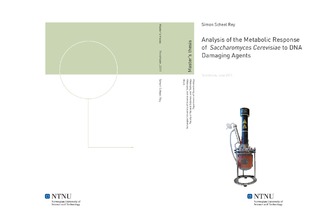| dc.description.abstract | Saccharomyces cerevisiae, commonly known as Baker s yeast, is a eukaryotic model organism widely used in biotechnology research. Its genome has a high degree of similarity to humans, and research done on S. cerevisiae can give us a better understanding of the mechanisms involved and the cellular responses to anti-cancer drugs. Yeast is therefore usefool in increasing the effectiveness of anti-cancer drugs.The main goal for this master thesis was to investigate the metabolic response of S. cerevisiae to DNA damaging compounds. Methods for cultivation of S. cerevisiae in shake flasks or in a bioreactor, for sampling and extraction of cells, and for analysis of the sample using GC MS were developed. A custom Deconvolution Reporting Software library was created, and used to analyze the metabolic response of S. cerevisiae to 5-fluoruracil (5FU), a widely used anti-cancer drugs. The publicly available software FiatFlux 1.6X was used for metabolic flux analysis of S. cerevisiae grown in medium containing labeled [U-13C]-glucose and in the presence of 5-fluorouracil or methyl methanesulfonate (MMS), a model alkylating agent.An overall decrease in the amount of intracellular metabolites was observed as a response to addition of a growth-inhibiting dose of 5FU, while no clear response was observed for a lower, more tolerable dose. Growth of S. cerevisiae under the presence of 5FU resulted in a different cellular response than growth under the presence of MMS. The presence of both DNA-damaging agents resulted in a decrease in the ratio of the fluxes leading to mitochondrial acetyl-CoA compared to an unstressed culture, possibly indicating a reduction in the activity of the TCA cycle. The 5FU stressed cells showed an increase in conversion of fumarate to oxaloacetate and the subsequent export out of the mitochondrion, while the MMS stressed cells showed a decrease of this flux.The experimental methods can be further refined to obtain data of higher quality, and thus allow a more complete metabolic profile to be created. The conditions for derivatization can be optimized to ensure a complete derivatization of all metabolites, the DRS library can be expanded to include a wider range of metabolites, and experiments of stressing the cells performed in a chemostat can eliminate any effects the differences in specific growth rates might have on the metabolome or fluxome of S.cerevisiae. | nb_NO |

